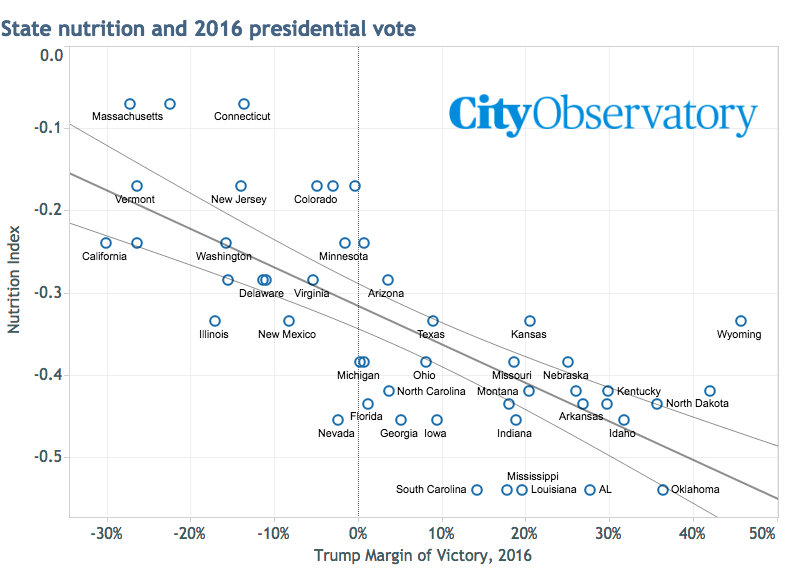What City Observatory did this week
1. The correlation between bad diets and vote for President. A new research paper has distilled mounds of data on consumer shopping behavior gleaned from supermarket scanners, and combined it with nutritional information to estimate how healthy or unhealthy average dietary patterns are in different parts of the country. The county-level map of poor nutrition shows some strong similarities to the familiar red/blue electoral maps. We looked at the correlation between state level vote for President in the 2016 election and state nutritional scores and found that diet is a statistically significant explanation of who voted for President.
2. Barack Obama on gentrification. Former President Obama has committed to building his Presidential Center in Chicago’s Jackson Park. Last month, he spoke to a community meeting about the possible impacts the center would have on the neighborhood, and tackled head-on questions of gentrification.
3. Stranger than fiction: airbags for pedestrians. A couple of years back, we poked fun at Google’s patented idea to embed super-adhesive in the surface of car hoods and fenders so that any pedestrian they struck would stick to the car, rather than flying away. Instead, we proposed remotely activated pedestrian airbags and vehicles could trigger if anyone got in their way. Truth is, we weren’t far off the very crazy mark: GM and other car manufacturers have patented external airbags on cars to cushion pedestrians. All the fascination with these technical fixes distracts us from the bigger question: why do we build cities where pedestrians have to contend with fast-moving cars?
4. City women: In observance of International Women’s Day, we’re taking a moment to thank the dozens and dozens of women urbanists whose research and analysis improves our understanding of urban issues. We’ve got links to their twitter accounts and web pages. If you aren’t following these women, take a look.
Must read
1. Possible solutions for California’s housing shortage. Gabriel Metcalf, the director of San Francisco’s SPUR has a comprehensive essay in the Journal of Economic Perspectives addressing the causes and possible solutions for California’s housing problems. In expensive cities, policy makers struggle to address affordability by subsidizing low income housing, and sometimes imposing rent control. But the structure of housing market regulation–and the dominance of local zoning–inherently restricts the supply of housing in ways that overwhelm these affordability policies. Zoning choices are rooted deeply in the local political and institutional structure, and it’s likely that only fundamental reforms to this regime will make a meaningful difference to affordability.
2. Dubious housing cost comparisons. Todd Litman, the tireless leader of the Victoria Transportation Policy Institute, once again trains a skeptical eye on claims in the International Housing Affordability Survey (IHAS) about which cities have the lowest living costs. The IHAS looks at the sales price of owner-occupied single family homes in different areas to establish its rankings, and generally finds that houses sell for less in sprawling, auto-dependent metros and economically declining regions. LItman points out that the ranking is biased for a number of reasons; chiefly because it ignores the higher transportation costs associated with sprawling development, and ignores the presence of many lower cost housing alternatives.
“The Survey only considers a limited set of housing types, geographic areas and impacts, which exaggerates the affordability of detached, urban-fringe housing and the unaffordability of compact housing in walkable urban neighborhoods. It blames housing unaffordability on urban containment regulations, although they are actually uncommon and less costly than regulations which limit affordable infill. It ignores many sprawl costs and Smart Growth benefits.”
3. The Guardian no doubt got a lot of clicks last week with a story claiming that the average Uber driver made just $3.37 an hour and that as many as 40 percent of Uber drivers were losing money. The trouble–the numbers, from a study released by MIT’s Center for Energy and Environmental Policy Research, were simply wrong. Uber and several independent scholars pointed out some serious flaws with the study’s survey methodology and calculations. The study’s author’s quickly admitted their mistakes, and revised their calculations, now conceding that their figures show median driver earnings are something on the order of $8.55 to $10.00 per hour–not great, but not below the minimum wage. The story points up two conclusions: First, researchers and journalists shouldn’t jump to publish (or repeat) implausible findings (the errors were pretty much in plain sight if either had seriously solicited independent views). Second, if ride-hailing companies were required to report hours worked and compensation paid like other employers, this would be a non-issue. The Bureau of Labor Statistics routinely publishes detailed hourly earnings data for workers in virtually every common industry and occupation. This shouldn’t be a trade secret that can only inaccurately be judged by arduous and frequently irreproducible methods.
In the news
Planetizen highlighted our recent commentary arguing that road pricing shouldn’t be applied just to ride-hailed vehicles.



